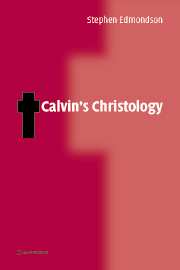2 - Christ and the covenant history
Published online by Cambridge University Press: 22 September 2009
Summary
In his letter to the Polish Brethren, Calvin directs his readers to Scripture as the source for shaping Christology, but he does not tell us to look in the first place for Christological definitions there. Rather, he asks us to begin by attending to God's witness in Scripture to God's economy for our salvation. We are first to consider how God, who is the author of history and of the scriptural texts which record it, administers God's relationship with the world and with God's Church in particular. From there we are to draw images, concepts, and the dynamic that give form to how we speak of Christ. We do this because there is an intimate relationship between this economy and who Christ is; we can even say that Christ is the substance of the economy.
Our task in this chapter is to examine how Calvin describes this economy – to find the rubrics under which he construes God's redemptive relationship with the world – so that we might begin to identify the Christological vision that emerges out of such a description. By proceeding in this way, we are taking Calvin at his word that Christology follows and is determined by the understanding of this economy that we have been given in Scripture.
- Type
- Chapter
- Information
- Calvin's Christology , pp. 40 - 88Publisher: Cambridge University PressPrint publication year: 2004



